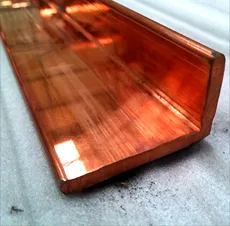1. Introduction
Just 24 hours ago, global copper prices surged past $9,800 per metric ton due to supply constraints in Chile and rising demand from renewable energy projects—highlighting just how critical raw copper forms like the copper rod are in today’s industrial landscape. Whether you’re an electrician, plumber, or scrap recycler, chances are you’ve encountered a copper rod or one of its many variants.

But what exactly is a copper rod, and why does it matter so much? From grounding systems to high-precision welding, copper rods serve as foundational components in countless applications. Let’s break it all down.
2. What Is a Copper Rod?
A copper rod is a solid cylindrical bar made primarily of high-conductivity copper. It’s typically produced through continuous casting or extrusion and comes in various diameters and lengths. Known for excellent electrical and thermal conductivity, corrosion resistance, and ductility, rod copper is a go-to material in engineering and infrastructure.
Common grades include electrolytic-tough-pitch (ETP) copper and oxygen-free copper, each suited for specific technical requirements. You’ll often hear terms like copper round bar or round bar copper—they refer to the same product: a smooth, circular cross-section copper rod.
3. Types and Specialized Copper Rods
Not all copper rods are created equal. Depending on the application, you might need a specialized version:

- Copper earth rod or earthing rod copper: Used in grounding systems to safely channel electrical faults into the earth.
- Ground rod copper and copper bonded earthing rod: These often feature a steel core with a thick copper coating (also called copper bonded steel) for strength and conductivity.
- Copper clad ground rod and copper clad steel earth rod: Similar to bonded rods but made via metallurgical bonding for enhanced durability.
- Copper brazing rod and copper to copper brazing rods: Designed for joining copper parts without melting the base metal.
- Copper welding rod, copper rod for welding, and copper to copper welding rod: Used in specialized welding processes where pure copper filler is needed.
Each type serves a distinct purpose, balancing cost, performance, and environmental demands.
4. Copper Rod vs. Other Copper Forms
While copper rod is essential, it’s part of a broader family of copper products. For instance:
- Copper strip (or copperstrip): A flat, thin form used in busbars, electronics, and earthing. Variants include flat copper strip, beryllium copper strip, nickel plated copper strip, and 1mm copper strip.
- Copper bar and copper flat bar: Wider and thicker than strips, often used in power distribution as copper bus bar or flexible copper bus bar.
- Copper pipe tube and aircon copper pipe: Hollow forms used in plumbing and HVAC systems, like 15mm copper pipe or 22mm copper tube.
These formats—rod, strip, bar, pipe—are chosen based on mechanical needs, conductivity, and ease of installation.

5. Practical Applications Across Industries
Copper rods are everywhere:
- Electrical: As earthing rod copper in substations or lightning protection systems.
- Construction: In copper pipework for water and refrigerant lines (e.g., air conditioning copper pipe).
- Manufacturing: As feedstock for drawing wire or machining parts.
- Recycling: Scrap dealers often seek copper rod price info when buying clean, unalloyed rods.
Even niche uses exist—like copper tape for snails in gardening (a natural deterrent)—though that’s more related to copper strip than rod.
6. Pricing and Market Considerations
The copper rod price fluctuates with LME (London Metal Exchange) rates. Similarly, earthing rod price depends on whether it’s solid copper or copper bonded. Copper bonded ground rods offer a cost-effective alternative to solid versions while maintaining good conductivity.
For those sourcing materials, searching ‘copper strip near me’ or ‘copper bars for sale’ can yield local suppliers—but always verify purity and certification, especially for electrical use.
7. Recycling and Wire Stripping Tips
Many confuse copper rods with stripped wire. If you’re recycling, knowing the best way to strip copper wire matters. Avoid burning copper wire for scrap—it’s illegal in many areas and releases toxic fumes.
Instead, use mechanical strippers for the fast way to strip copper wire. The goal is clean, bare copper for maximum scrap value. Whether stripping wire for recycling or stripping copper cable for resale, efficiency and safety are key.
8. Conclusion
From the humble copper earth strip 25x3mm price tag to high-end copper alloy strip used in aerospace, copper in all its forms remains indispensable. The copper rod, with its versatility in earthing, welding, and fabrication, stands as a cornerstone of modern infrastructure. As global electrification accelerates—from EVs to solar farms—demand for quality copper rod and related products will only grow.
Our Website founded on October 17, 2012, is a high-tech enterprise committed to the research and development, production, processing, sales and technical services of ceramic relative materials such as What. Our products includes but not limited to Boron Carbide Ceramic Products, Boron Nitride Ceramic Products, Silicon Carbide Ceramic Products, Silicon Nitride Ceramic Products, Zirconium Dioxide Ceramic Products, etc. If you are interested, please feel free to contact us.

